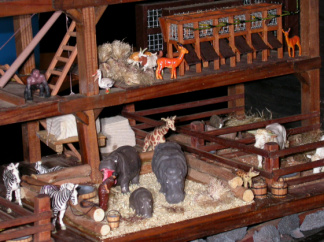How Many Unclean Animals Were On The Ark
How many animals did Noah's Ark carry? Was information technology overloaded? Did God require every beast he created be saved on the transport?
Though information technology is often causeless, the Bible does non state that God required all the animals in existence be taken on the Ark. Creatures that either already lived in water, or could hands survive in information technology, did not need to be transported on the transport.
For example, animals such as fishes, dolphins, whales and and so on could hands alive in the overflowing waters without needing any assistance. Other creatures such as starfishes, ocean urchins, mussels, clams, corals, jellyfishes, sponges and others would likewise not need the services of the Ark. Additionally, most types of snakes, alligators and so on would exist able to live in water. Many insects, worms, and other creeping animals could survive as well in liquid and therefore not need to be carried on the Ark.
Iii divine requirements
God gave Noah three requirements that animals immune on the Ark had to meet. They had to be air breathing, terrestrial (land-based) and had to be capable of interbreeding (see Genesis 6:17, nineteen - 20, vii:22).
Furthermore, of all those that qualified for inclusion on the Ark, 7 of every animate being that was considered "clean" just only two of every animal considered "unclean" was to be taken (Genesis vii:2 - 3). This meant, for case, that while 7 sheep initially entered the nifty ship merely ii pigs got on it.

Clean and Unclean
The Biblical criteria for identifying whether an beast was clean (i.e. fit for human consumption) or unclean (i.e. detrimental to man'due south health if consumed) is found in Leviticus 11 and Deuteronomy 14. Warm-blooded beasts that have both separate hooves and chews a cud is clean (Leviticus 11:3, Deuteronomy 14:half dozen). Animals in this category include cattle, deer, goats and many others (encounter our consummate list of make clean foods). Those that practise not have a split up hoof and exercise not chew a cud are designated unclean.
Additionally, animals were considered unclean if it had a split hoof but did not chew cud or vice versa. For example, although swine (pigs) have separate hooves they exercise not chew the cud and are therefore unclean (Leviticus 11:7, Deuteronomy fourteen:8). Camels, who do chew the cud but who do non have divide hooves are also unacceptable (Leviticus 11:4, Deuteronomy 14:7).
Why seven?
Why did God require seven of the clean only only ii of the unclean animals? It is because those considered clean could be used for food and therefore it was important to have extra breeding stock. They could also potentially be offered in cede to God (as Noah did at the end of the flood, Genesis 8:xx).
How many were saved?
And then, given all of the above, how many animals did the Ark save from the overflowing? There are several different estimates for the number kept from the floodwaters. The book "The Genesis Overflowing" estimated that approximately 35,000 creatures were on lath the transport. In some other book, "Noah's Ark - A Feasibility Study" past John Woodmorappe, it states that simply near 2,000 animals would demand saving.
Could a ship similar the Ark be built, more iv,000 years ago, that could accomodate (for the sake of argument) a conservative number of 40,000 animals?
Many biologists state that the boilerplate size of most vertebrates is the size of a sheep. The living space each sheep needs is 11.12 cubic feet (.31 cubic meters). When we multiply twoscore,000 past 11.12 cubic feet nosotros get in at 445,000 cubic feet total (12,601 cubic meters). Given that the total volume of the ship God allowable to be built was conservatively 1.5 million cubic feet (42,475 cubic meters), the Ark would exist less than 30% full with lots of room to spare for the animals!
Source: https://www.biblestudy.org/biblepic/animals-on-noah-ark.html
Posted by: millersathimpiou.blogspot.com

0 Response to "How Many Unclean Animals Were On The Ark"
Post a Comment